Taiwan Shrine/Taiwan Grand Shrine
臺灣神社/臺灣神宮
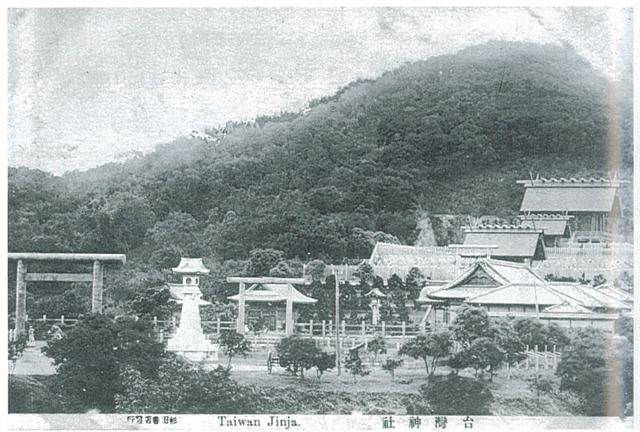
The Taiwan Grand Shrine was built as Taiwan Shrine in 1901 atop Jiantan Mountain (The Grand Hotel nowadays). Taiwan Grand Shrine was the tutelary shrine of Taiwan and the most important Shinto shrine in Taiwan.
臺灣神社(亦稱臺灣神宮)建於西元1901年,原址位於臺北市劍潭附近的劍潭山山頂(今圓山大飯店),是台灣日治時期所建的神社中最為重要的一座,稱作「臺灣總鎮守」。
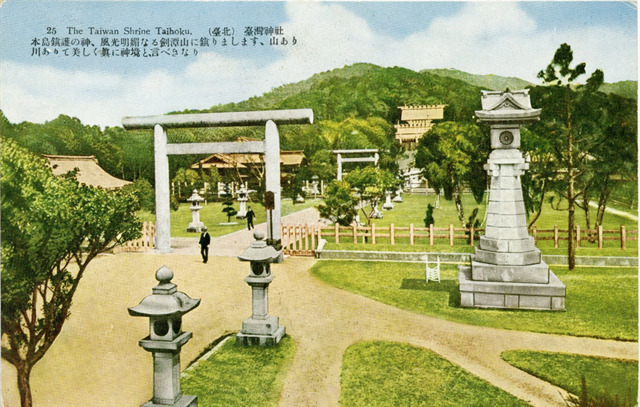
The shrine ranking of Taiwan Shrine is “Kampei Taisha”, which was the highest ranked shrine of Japan overseas shrine. Although it’s not the first shrine in Taiwan (actually it’s the third. The first shrine in Taiwan is the Koxinga Shrine in Tainan, and the second is the Jinguashi Shinto Shrine.), but it’s the only “Kampei Taisha” in Taiwan. The Taiwan Shrine was mainly dedicated to the Prince Yoshihisa, who led the troops to participate in the Japanese invasion of Taiwan but then died in Taiwan. Besides of Prince Yoshihisa, the shrine also worshiped to the Three Deities of Cultivation. Taiwan Shrine was renamed as Taiwan Grand Shrine after Amaterasu-omikami was added into shrine for worshiping in June, 1944.
臺灣神社的社格為官幣大社,雖然並不是臺灣的第一座神社(實際上是第三座,第一座為位於台南的開山神社,然後是位於瑞芳的黃金神社),卻是臺灣唯一的官幣大社,亦是日本眾多海外神社中社格最高的,神社主要奉祀當年甲午戰爭後,領兵接收台灣卻歿於台灣、後被神格化的北白川宮能久親王以及開拓三神-大國魂命、大己貴命及少彥名命。在1944年6月增祀天照大神後而改稱為臺灣神宮。
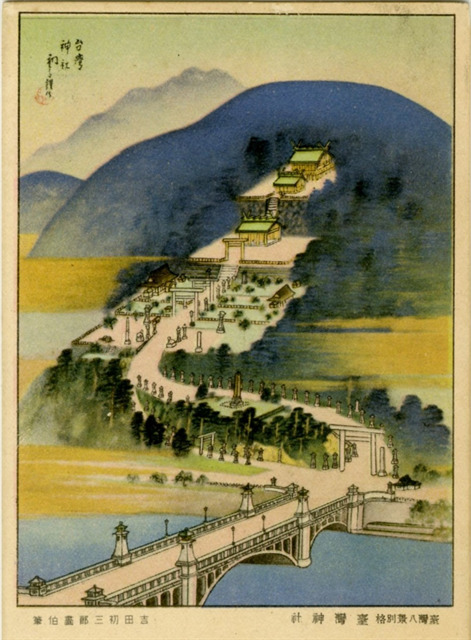
Taiwan Shrine covers an area of about five hectares. It equipped with facilities such as komainu, torii, stone lanterns, shrine affairs offices, temizuya, worship hall, and main hall. The shrine follows the slopes of Jiantan Mountain and divided into three levels from the bottom up. The main hall was at the highest position. At that time, Government-General of Taiwan especially built Meiji bridge (Zhongshan bridge nowadays) that across over the Keelong river, to connect the traffic between the Shrine and the downtown area. They also widen and renovated the road that leading to the Taiwan Shrine. The road was named as “Chokushi Road”, which is the Zhongshan North Road in present-day.
臺灣神社占地約五公頃,設置狛犬、鳥居、石燈籠、社務所、手水舍、拜殿、本殿等設施, 神社順著劍潭山的山坡,由下而上,分為三層,隨著階梯參道逐層而上,本殿位在最高處的位置。當時,臺灣總督府特別興建了跨越基隆河的「明治橋」(今中山橋),以連接神社與市區的交通;並且拓寬及整修市區往臺灣神社的道路。 這條道路被稱為「敕使街道」,即是今日的中山北路。
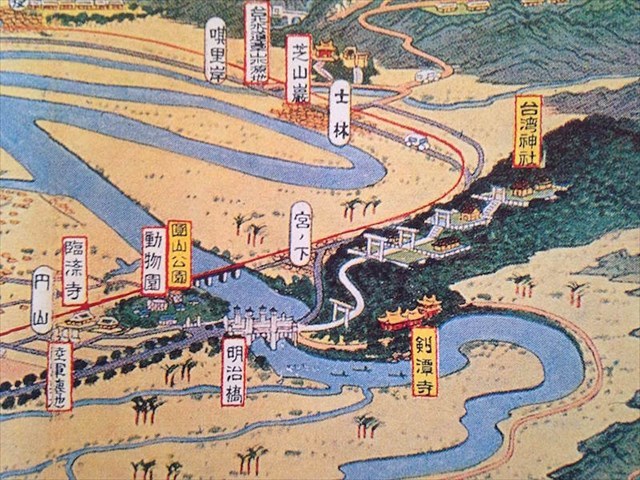
At the beginning of the completion of the Taiwan Shrine, the pilgrims can take the Danshui Railway train that was completed at the same time as the Taiwan Shrine to the Yuanshan, and then walk across the bridge to the shrine to pay homage. In 1915, Miyanoshita Station began operations, and people can get off at this stop and walk to the shrine for five minutes. Miyanoshita Station was located near the Jiantan Youth Activity Center. The ponds in the activity center was used to be the timber pond of the shrine. Since the shrine needs to be renovated (about every 20 years), plus the expansion of the shrine, the wood is first immersed in, in case they need it at any time. After the war, Miyanoshita Station was renamed as Jiantan Station, but it’s different from the location of today's MRT Jiantan Station.
臺灣神社落成初期,參拜民眾可搭乘與台灣神社同時落成的淡水線鐵道火車到圓山駅,再步行過橋到神社參拜。1915年,「宮ノ下乘降場」(宮ノ下駅)開始營運,民眾可到此站下車,再徒步五分鐘到神社參拜。宮ノ下駅位於今日劍潭青年活動中心附近,活動中心裡內池塘是當時神社的蓄木池,由於神社本身需要整修(約每二十年),加上神社本身擴建的關係,將木材是先浸泡在此,以備隨時取用。宮ノ下駅於戰後改稱劍潭站,但與今日捷運劍潭站之所在地有所差異。
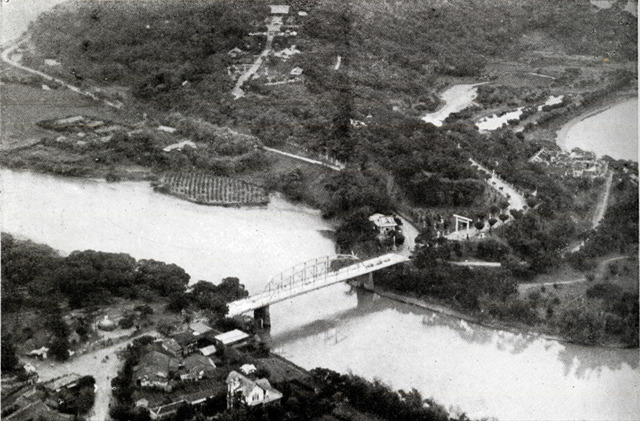
Taiwan Shrine was originally scheduled to move to the new site of the Taiwan Grand Shrine (today’s Yuan Shan Club of Taipei) in December 1944. However, on October 25 of the same year, a civil aircraft flying to Songshan Airport crashed when it landed. The fire caused by was destroyed the Taiwan Grand Shrine that was just been completed. It happened during the end of WWII, the Japanese government was unable to repair the shrine. The following year, Japan defeated and surrendered, ending the colonial rule in Taiwan. After the R.O.C Government came to Taiwan in 1945, most of the Japanese shrines built in Taiwan were destroyed or used for other purposes. The Taiwan Shrine was also demolished and converted into the "Taiwan Hotel". In 1952, it was renamed as "The Grand Hotel".
臺灣神社原訂於1944年12月遷至臺灣神宮新址(今圓山聯誼會),不料同年10月25日, 一架飛往松山機場的民航機在降落時失事墜毀,其引發的大火焚毀了才剛完工的臺灣神宮。 此時是二戰末期,日本政府已無力再修復神宮。次年,日本戰敗投降,結束了在臺的殖民統治。1945年國民政府來臺之後,日本在臺灣興建的神社多半遭受破壞或挪作他用,臺灣神社也遭拆除改建為「臺灣大飯店」,1952年改稱「圓山大飯店」至今。
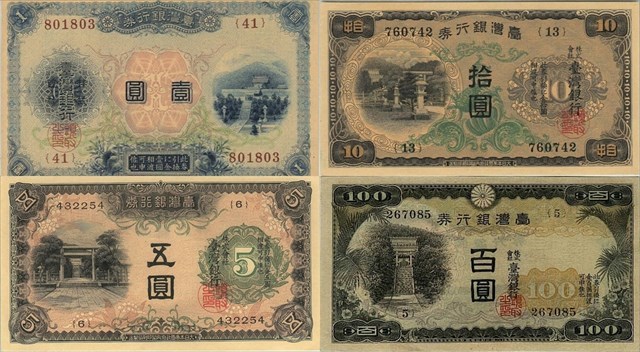
The picture above is "Taiwanese yen", which was the currency of Japanese Taiwan from 1895 to 1946. The patterns at front side of the Taiwanese yen are Taiwan Shrine, and the backside are Eluanbi Lighthouse.
上圖為臺灣銀行券,是日治時期所使用的貨幣,其正面圖案皆為臺灣神社,背面則是鵝鑾鼻燈塔。
The remains of Taiwan Shrine 神社遺跡
When the Taiwan Shrine was rebuilt as Taiwan Hotel as the end of the war, the torii, the shrine affairs offices and the temizuya were still there, but there were no any buildings of shrine left today, only a few of the remains were found, and the rest of remains were scattered. The remains of the Taiwan Shrine that are known to be retained are as follows:
臺灣神社在戰爭剛結束改建為臺灣大飯店時,鳥居、社務所、手水舍都還在,但在今日原地已沒有留下任何建築,僅能找到部分的遺跡,其餘遺跡物件目前也散落各處。目前所知仍留存之遺跡物件如下:
- A pair of komainu dedicated by Ishizuka Eizo, the 13th Governor-General of Taiwan, is now placed at the plaza of the Grand Hotel.
台灣總督石塚英藏所奉獻之石獅一對目前置於圓山飯店廣場。
- Beside the komainu at the plaza of the Grand Hotel, there’s a monument that wrote “劍潭勝跡” which means “the famous historical site of Jaintan”. The upper of the monument was originally “the monument of dedicate weapons”, and the lower was originally the base of “Japanese naval victory monument”.
圓山飯店廣場石獅旁之「劍潭勝跡」碑,上半部為原台灣神社內的「獻兵器紀念碑」,下半部則原為由日本海軍戰利砲構成之「日本海戰捷紀念碑」之下方台座。
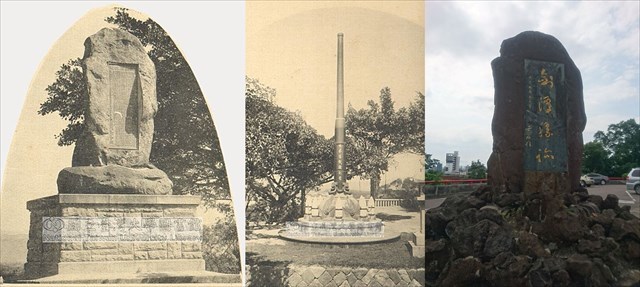
- The bronze dragon sprinkler that originally used at the fountain of the Taiwan Shrine, was painted in golden color and renamed as “the golden dragon of hundred years”, placed inside the “Golden Dragon Restaurant” of the Grand Hotel.
原神社內噴水池之青銅登龍噴水器現置於圓山飯店金龍廳內,被塗上金漆後改稱「百年金龍」。
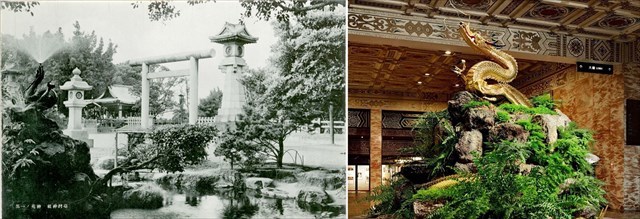
- A pair of komainu dedicated by a Taiwan army senior officer, is now placed at the entrance of the Jiantan Park.
臺灣陸軍高等官所奉獻之狛犬一對目前置於劍潭公園入口處。
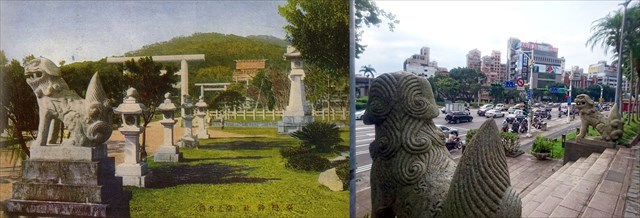
- The only remaining stone lantern of Taiwan Shrine is currently placed in Taipei Municipal Children´s Recreation Center, near the exit of Zhongshan North Road.
僅存之神社石燈籠一座目前置於兒童育樂中心,靠近中山北路出口處。
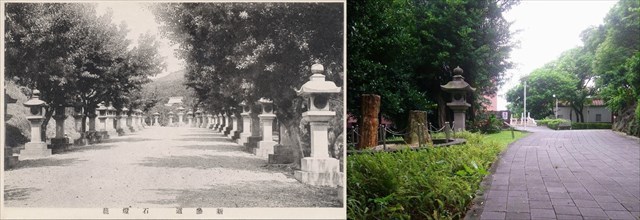
- A copper bull dedicated by a Buddhist group in Hokkaido, is placed at the eastside of the plaza that in front of the National Taiwan Museum; and a bronze bull dedicated by a Japanese businessman is placed at the westside. Although the two bull statues looks similar, but their casting year, material and details are all differents.
北海道佛教團體獻納紅銅牛一尊,現置於臺灣博物館前廣場東側;日本商人川本澤一獻納青銅牛一尊則置於廣場西側。兩隻銅牛雖外型相似,但實際上鑄造年份、材質以及外型細節皆不同,細看仍可看出差異。
- A pair of komainu dedicated by Banqiao Lin Family, is placed in front of the Hong Teng-yun Memorial Arch inside the 228 Peace Park.
板橋林本源家族所奉獻之石獅一對目前置於二二八公園內急公好義坊前。
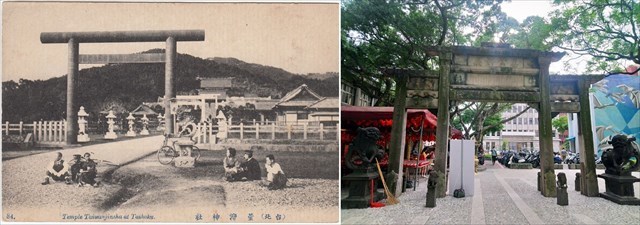
- The dedicated cannons are placed in front of the Armed Forces Museum.
獻納砲目前置於國軍歷史文物館前。
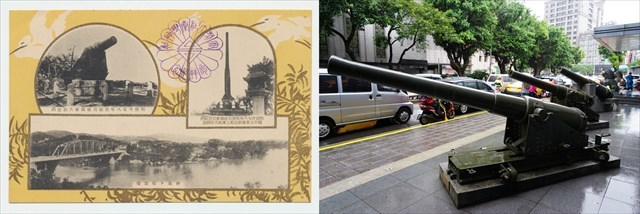
- Two Taiko drums of the Taiwan Shrine are keep by Wanhua Longshan Temple and Xinzhuang XiangRenHe Drums separately.
神社原有太鼓兩座,分別由萬華龍山寺以及新莊響仁和鐘鼓藝工坊所收藏。
- The shrine monument is placed inside the LinKou Zhulinshan Guanyin Temple.
鎮座紀念碑置於林口竹林山觀音寺內。

- Part of the torii was sold by the government and then bought by Li Mei-shu as the material of construct the Sanxia Zushi Temple. After carvering, the torii became 8 pillars in the main hall of Sanxia Zushi Temple. The rest of the material is placed in the warehouse of the temple.
政府拍賣神社部分鳥居,後被李梅樹以低價買去作為修建三峽清水祖師廟之石材,經雕刻後成為正殿圓柱八根,尚有一半石材未使用,目前置於祖師廟倉庫中。

- The expanded part of the Taiwan Grand Shrine (or called “the new land”), although the remains are not that obvious, but still has the base of the lantern located at the parking lot of Yuan Shan Club of Taipei. And parts of stone walls located beside of the swimming pool of Yuan Shan Club of Taipei.
其他1944年擴建爲臺灣神宮(稱爲新境地)部分,遺跡雖不明顯,仍有春日燈的下半部在圓山聯誼會停車場,及部份石垣在圓山聯誼會游泳池旁。
To log this virtual, you must complete the following tasks:
- Visit all the five stages (including the posted coordinates) that listed in the cache page physically.
- Find the remains of Taiwan Grand Shrine at each stage.
- Take a photo in front of the remains at each stage, the photos must contain either you (no face required), your personal object, a piece of paper with your geocaching name, or any else that would makes your photos unique. Be creative!
- Once all the tasks above have been done, don’t forget to post the required photos to your log. Each found log should have 5 photos attached.
Please note...
- Your log will be deleted if...
- one or more of the required photo(s) at the stages is/are not attached to the found log.
- the photos are not yours, or the photos didn’t contain anything that mentioned in the task 3.
- You don’t need the approval to log your found. Once you have completed all the tasks, you could post your log online.
- Some of the stages don’t have any light at night, visit each stage at daytime would be recommended.
- If you have more photos to share, don't hesitate and feel free to post them online.
(And I'll be happy to know if you visit other remains that mentioned above but not listed in the stages. But it's definitely not required!)
REF: 台湾旧神社故地への旅案内p.10-15, 『海外神社』(跡地)に関するデータベース, 臺灣舊照片資料庫, wikipedia
Virtual Rewards 2.0 - 2019/2020
This Virtual Cache is part of a limited release of Virtuals created between June 4, 2019 and June 4, 2020. Only 4,000 cache owners were given the opportunity to hide a Virtual Cache. Learn more about Virtual Rewards 2.0 on the Geocaching Blog.
